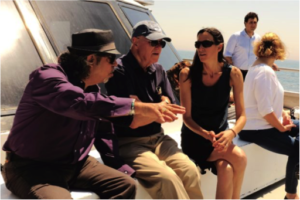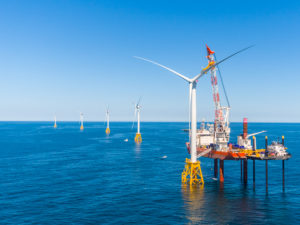Block Island Project Shows the Enormous Opportunity of Offshore Wind Power
Labor union leaders from Connecticut, Maine, Massachusetts, New York, Rhode Island, Vermont, and Washington, D.C. toured the first operational commercial offshore wind project off Rhode Island this summer to see the unparalleled contribution that offshore wind can make in creating good jobs in a clean energy future.
As the Rhode Island Fast Ferry headed out of the dock, it became clear that the labor union leaders aboard would enjoy more than a beautiful day. The hundred or so industry leaders headed to catch a glimpse of a one-of-a-kind innovation—five colossal 600-foot turbines that represent the first offshore wind development in the United States.
Nearly all of the participants saw the operation of the country’s first offshore wind farm and with it, the scale of economic opportunity that is the future of the clean energy economy.
The inspiration was palpable. Before the project was complete, Block Island residents relied on dirty diesel fuel from out of state that risked damaging the eco-tourism that supports the Island’s economy. Now, the Block Island Wind Farm powers 17,000 homes. That is enough to power all Block Island homes, lower utility bills, and transport additional power back to the state’s main grid—all while providing local jobs with positive long-term outlook for what could soon be a booming industry.
With the installation of the Block Island Wind farm in 2016, for the first time in our history, the United State began to realize its potential as a potential offshore-wind powerhouse—and set the stage for responsible development. Not only is Block Island harnessing local renewable energy that will not ever run out, it is creating hundreds of jobs in the process. The project itself created over 300 jobs in Rhode Island alone—thanks in large part to a Project Labor Agreement. For local unionized workers in 10 different Building Trades locals and 30 unionized contractors and subcontractors, this project meant food on their tables and money in their pockets. What’s more, the developers worked with environmental organizations to come to agreements to protect endangered species.
Labor leaders were involved each step of the way. Scott Duhamel, Secretary Treasurer, Rhode Island Building and Construction Trades Council explained:

Scott Duhamel (left) deep in conversation during the tour. Photo by NWF
“We, at the RI Building and Construction Trades Council, are fiercely proud of our initial advocacy that lead to the great end results of putting the first wind turbines in America’s waters, and even prouder that our member’s skills were utilized in making and completing the groundbreaking project, and hopefully, helping to jumpstart a whole new industry.”
Now with nearly 26,000 megawatts of offshore wind committed by state governments and about 3,000 megawatts in the pipeline for near-term development, the U.S. is approaching prime time for realizing significant job creation and economic development. The focal point of the offshore-wind jobs conversation had centered on construction. But seeing the size of the turbines helped passengers imagine the quantity of materials needed to achieve domestic goals. They quickly saw the effort required to manufacture the towers and foundations themselves, in addition to installing them. As the industry grows, sourcing components domestically represents a significant opportunity to help revitalize American manufacturing.

Block Island Wind Farm Construction. Photo by Deepwater Wind now Ørsted US Offshore Wind.
“American manufacturing workers have immense opportunity to supply the thousands of component parts for the offshore wind industry—and, in turn, offshore wind developers have the opportunity to strengthen American manufacturing,” said Del Vitale, director of United Steelworkers District 4. “Our union was proud to help show key partners the size and complexity of the Block Island turbines so we can all work together to seize these opportunities.”
The Special Initiative for Offshore Wind’s white paper predicted nearly $70 billion in buildout of U.S. offshore wind supply chain by calculating growth in a number of sectors, including wind turbines and towers; turbine and substation foundations; upland, export, and array cables; onshore and offshore substations; and marine support, insurance, and project management.
The wind over our oceans has enough technical capacity to provide enough energy to power every home in America twice over. It is time that we roll up our sleeves and work together to harness the enormous opportunity of offshore wind power. Seizing the economic and environmental benefits of this unparalleled renewable energy resource will provide tens of thousands of highly skilled jobs, revitalize coastal communities and ports, and deliver reliable clean energy where we need it most